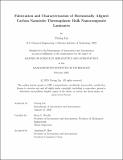Fabrication and Characterization of Horizontally Aligned Carbon Nanotube Thermoplastic Bulk Nanocomposite Laminates
Author(s)
Lin, Yuying
DownloadThesis PDF (23.21Mb)
Advisor
Wardle, Brian L.
Terms of use
Metadata
Show full item recordAbstract
Carbon nanotubes (CNTs) have advantaged mass-specific mechanical properties and excellent thermal and electrical conductivity, making them an attractive reinforcement for composite systems. Due to an increasing need for more sustainable materials, incorporation of CNTs into thermoplastic matrices presents a promising solution for recyclable and repairable polymer nanocomposites (PNCs). This thesis presents an approach to fabricating and characterizing thermoplastic PNCs that incorporate ultra-high volume fractions of horizontally-aligned carbon nanotubes (HA-CNTs). An MIT-developed bulk nanocomposite laminating (BNL) process was adapted to fabricate multi-ply, unidirectional composites with poly(methyl methacrylate) (PMMA) and acrylonitrile butadiene styrene (ABS) matrices. For the HA-CNT/PMMA system, the BNL process was tailored to fabricate 4-ply and 8-ply laminates with fiber volume fraction v_f > 45 vol.%, using a 9 wt.% PMMA in anisole solution. Through characterization via X-ray microcomputed tomography (µCT), scanning electron micrography (SEM), thermogravimetric analysis (TGA), Fourier transform infrared (FTIR) spectroscopy, and polarized Raman spectroscopy, HA-CNT/PMMA laminates were shown to be free of micro-scale voids with weak or non-existent process-structure interactions, i.e., the CNTs had negligible effect on the polymer structure. TGA and IR helped demonstrate that the BNL process did not lead to decomposition or chemical changes to neat PMMA, and FTIR also revealed that the fabrication process did not induce covalent bonding between CNTs and PMMA. The crystalline behavior of PMMA was studied via dynamic scanning calorimetry (DSC) as well as X-ray diffraction (XRD), which demonstrated that BNL processing temporarily lowers neat PMMA glass transition temperature T_g by 4 ◦C with no permanent change after removal of thermal history. However, CNT inclusion leads to higher laminate T_g by 11 ◦C as shown through both DSC and dynamic mechanical analysis (DMA), which can be explained by CNT constraints on polymer chain movement as opposed to any crystallinity changes in the PMMA. Storage modulus of 8-ply HA-CNT/PMMA laminates was shown to be more than 600% of neat PMMA via DMA, while a decrease in tan(δ) of the laminate compared to neat PMMA indicates an increase in elastic behavior due to CNT inclusion. 4-ply laminates were subjected to a minimum radius of curvature test showing a ∼ 50% increase in yield strain compared to neat PMMA. Electrical properties of 4-ply HA-CNT/PMMA laminates were measured via 4-point probe testing, which demonstrated good Ohmic contact between CNTs, with conductivity of ∼ 2 × 10⁴ S m⁻¹ and anisotropy ratio of 1.2. A preliminary investigation was completed to evaluate the feasibility of using the BNL process for the HA-CNT/ABS system. Uniform suspensions of ABS in anisole were developed to use the BNL polymer infiltration method of spin-coating and vacuum-assisted infusion. It was shown that the nature of the ABS suspension led to uneven polymer distribution over the HA-CNTs. This work has demonstrated the successful incorporation of high volume fractions of aligned CNTs into PMMA thermoplastic matrices as well as the electrical conductivity of such composites, opening an avenue to the development of other high v_f thermoplastic PNCs and exploration into additional multifunctional capabilities.
Date issued
2025-02Department
Massachusetts Institute of Technology. Department of Aeronautics and AstronauticsPublisher
Massachusetts Institute of Technology